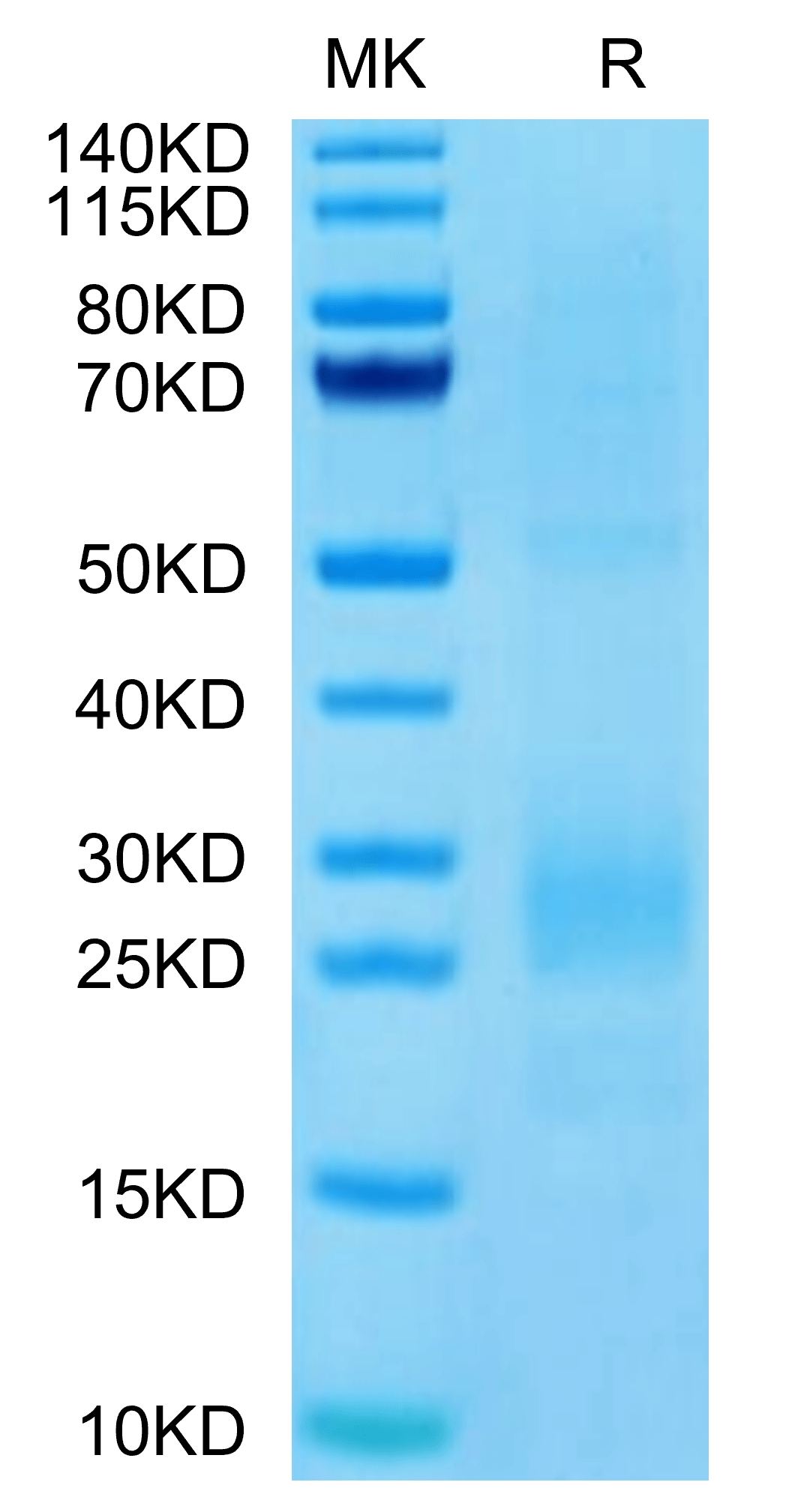| Weight | 1 lbs |
|---|---|
| Dimensions | 9 × 5 × 2 in |
| accession | P14174 |
| express system | HEK293 |
| product tag | C-His |
| purity | > 95% as determined by Tris-Bis PAGE |
| background | Macrophage migration inhibitory factor (MIF) is a pleiotropic cytokine with chemokine-like functions that increasingly is being studied in different aspects of cardiovascular disease. MIF was first identified as a proinflammatory and pro-survival mediator within the immune system, and a second structurally related MIF family member, D-dopachrome tautomerase (a.k.a. MIF-2), was reported recently. |
| molecular weight | The protein has a predicted MW of 13.44 kDa. Due to glycosylation, the protein migrates to 25-30 kDa based on Tris-Bis PAGE result. |
| available size | 100 µg, 500 µg |
| endotoxin | Less than 1EU per μg by the LAL method. |
Human MIF Protein 3145
$270.00 – $900.00
Summary
- Expression: HEK293
- Pure: Yes (SDS-PAGE)
- Amino Acid Range: Pro2-Ala115
Human MIF Protein 3145
| protein |
|---|
| Size and concentration 100, 500µg and lyophilized |
| Form Lyophilized |
| Storage Instructions Valid for 12 months from date of receipt when stored at -80°C. Recommend to aliquot the protein into smaller quantities for optimal storage. Please minimize freeze-thaw cycles. |
| Storage buffer Shipped at ambient temperature. |
| Purity > 95% as determined by Tris-Bis PAGE |
| target relevance |
|---|
| Macrophage migration inhibitory factor (MIF) is a pleiotropic cytokine with chemokine-like functions that increasingly is being studied in different aspects of cardiovascular disease. MIF was first identified as a proinflammatory and pro-survival mediator within the immune system, and a second structurally related MIF family member, D-dopachrome tautomerase (a.k.a. MIF-2), was reported recently. |
| Protein names Macrophage migration inhibitory factor (MIF) (EC 5.3.2.1) (Glycosylation-inhibiting factor) (GIF) (L-dopachrome isomerase) (L-dopachrome tautomerase) (EC 5.3.3.12) (Phenylpyruvate tautomerase) |
| Gene names MIF,MIF GLIF MMIF |
| Protein family MIF family |
| Mass 9606Da |
| Function Pro-inflammatory cytokine involved in the innate immune response to bacterial pathogens (PubMed:15908412, PubMed:17443469, PubMed:23776208). The expression of MIF at sites of inflammation suggests a role as mediator in regulating the function of macrophages in host defense (PubMed:15908412, PubMed:17443469, PubMed:23776208). Counteracts the anti-inflammatory activity of glucocorticoids (PubMed:15908412, PubMed:17443469, PubMed:23776208). Has phenylpyruvate tautomerase and dopachrome tautomerase activity (in vitro), but the physiological substrate is not known (PubMed:11439086, PubMed:17526494). It is not clear whether the tautomerase activity has any physiological relevance, and whether it is important for cytokine activity (PubMed:11439086, PubMed:17526494). |
| Catalytic activity BINDING 33; /ligand="substrate"; /evidence="ECO:0000269|PubMed:11170644, ECO:0000269|PubMed:17526494, ECO:0000269|PubMed:19090677"; BINDING 65; /ligand="substrate"; /evidence="ECO:0000269|PubMed:11170644, ECO:0000269|PubMed:17526494, ECO:0000269|PubMed:19090677"; BINDING 98; /ligand="substrate"; /evidence="ECO:0000269|PubMed:11170644, ECO:0000269|PubMed:17526494, ECO:0000269|PubMed:19090677" |
| Subellular location Secreted. Cytoplasm. Note=Does not have a cleavable signal sequence and is secreted via a specialized, non-classical pathway. Secreted by macrophages upon stimulation by bacterial lipopolysaccharide (LPS), or by M.tuberculosis antigens. |
| Structure Homotrimer (PubMed:23776208, PubMed:8610159). Interacts with CXCR2 extracellular domain (By similarity). Interacts with the CD74 extracellular domain, USO1, COPS5 and BNIPL (PubMed:11089976, PubMed:12681488, PubMed:12782713, PubMed:19454686, PubMed:23776208). |
| Target Relevance information above includes information from UniProt accession: P14174 |
| The UniProt Consortium |
Publications
Publications
| pmid | title | authors | citation |
|---|---|---|---|
| We haven't added any publications to our database yet. | |||
Protocols
| relevant to this product |
|---|
Documents
| # | ||
|---|---|---|
| Please enter your product and batch number here to retrieve product datasheet, SDS, and QC information. | ||















